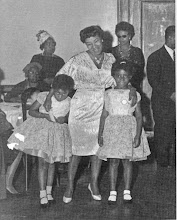
The French Collection Number 4: Sunflower Quilting Bee at Arles,
acrylic on canvas, tie-dyed pieced fabric border
73.5 x 80 inches 1991
Collection of Oprah Winfrey
Copyright Faith Ringgold 1991
This blog is devoted to exploring the photographs and art works of Faith Ringgold, with a particular focus on the photographs, documents and art related to the lives of Ringgold, her mother Willi Posey and her two daughters, Michele Wallace and Barbara Wallace.
We have always lived in the immediate context of a world mediated by visual art and photography. Both Barbara and Faith, Sr. are wonderful photographers in their own right. Barbara's oldest daughter Faith, whose major occupation is as a micro-biologist, is also a wonderful photographer, as well as the prime initiator of these blogs and my new website, www.michelefwallace.com. Barbara has also been tremendously helpful in getting the blogs started and I am looking forward to loading onto this site the many wonderful pictures she took of me during the heyday of my first book Black Macho and The Myth of The Superwoman in the late 70s. There are also the photographs she took of us around the time that Faith Jr. was born. I find that I am scarcely able to remember those chapters in my life which aren't bookmarked with photographs taken at the time.
I find that often when I look at a picture of myself, whether it is photographic or an original work of art, I can remember exactly what I was thinking at the time, and even though a moment before I had no recollection of the events, I can now remember the context, the people that were there and things that happened that I had completely forgotten. This is also true, sometimes, of photographs and images of others, photographs and/or images of news events or photographs which recall for me a landscape or a location or even a piece of furniture that was once in my life. It seems that these images occupy the key to the cryptic manner in which my memories are arranged, with the most important memories right beneath the surface of the gaze when my eye comes in contact with something visual that seems familiar. The next moment I am remembering something that I had completely forgotten, in oddly shaped fragments. Each time, for particularly powerful images, I will remember something altogether different.
I don't believe it has much to do with the intrinsic qualities or value of the image-- how well it is done according to some impartial standard of photography or art making-- although it may be that the images to which we attach the most meaning, significance and financial value are those that touch the widest array of people, or maybe they touch the richest people, or the whitest people, or the people who think of themselves as white. I don't know and I don't have much interest really in figuring this part out. All I know is that the images you care about (or that I care about) have to be safeguarded because there are a lot of people out there who wish to tell you that your visuals are without value or importance and that you should stop looking at them and get rid of them. This seems perhaps the unintended consequence of the digital revolution and everybody snapping cell phone images twenty-four-seven.
In short order, if it hasn't already happened, this endless proliferation of digital images which are crowding everybody's hard drive and so forth will drown out all sense of the place photography once occupied in our lives before computers and digital files and digital cameras. Not that digital cameras don't produce beautiful pictures. They can and they do. And it seems the difference between the real photographers and the fakes is as much in place as ever.
BUT it is going to get harder and harder for ordinary people (who have no time to study the situation) to tell the difference and to attach value and/or meaning to visual images in general, photographs perhaps in particular.



